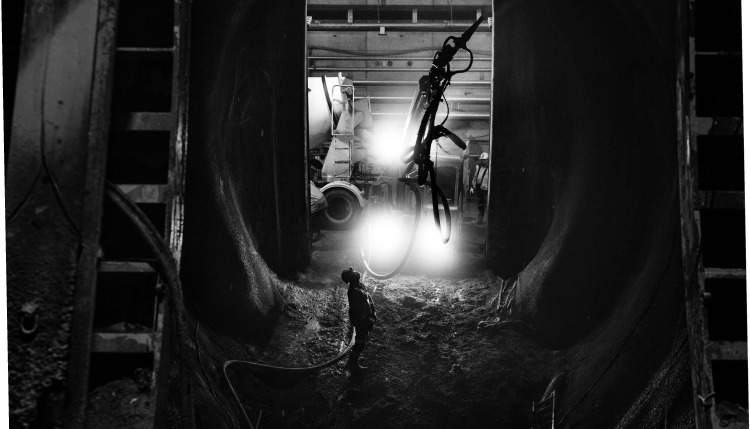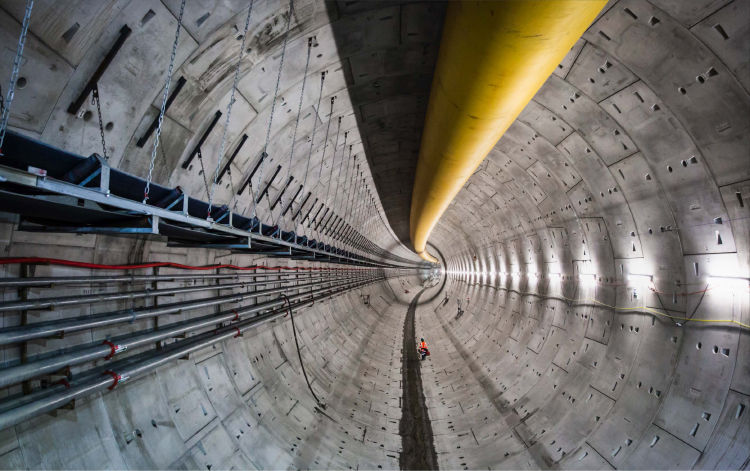Tracks, Belts & Blades
The Waterview Tunnel Project
ANDREW CLARK

GARETH MOON & TAMMY WILLIAMS Mana 2015 Inkjet print on archival Hahnemühle Photo Rag paper, 900 x 1050 mm.
The Waterview tunnel, connecting Point Chevalier and Mount Roskill, was a significant engineering and public works project carried out in the central Auckland suburbs from 2013–17. However, it took place largely out of sight beneath the feet of the city’s population, in darkness punctuated only by the glare of floodlights. For those who worked on it, the experience must have been odd, descending from banal suburban normality into an enclosed subterranean realm of machines and noise.
Tammy Williams and Gareth Moon’s The Waterview Tunnel Project represents an intriguing glimpse inside this mammoth undertaking. These photographs are firmly placed in the tradition of New Zealand documentary photography, recalling the works of Glenn Busch, whose Working Men series was perhaps an inspiration. One photograph shows a man in a hard hat, ear protectors and high-visibility gear (the ubiquitous uniform of contemporary labour) standing before a symmetrically folded piece of industrial machinery. Compositionally, this image strongly recalls Busch’s Charlie Roughton; Foreman, Metal Foundry (Wellington, 1982). In both, a single human figure stands in front of an imposing, monolithic industrial apparatus, reinforcing the subject’s humanity and vulnerability. However, the purpose of the esoteric mechanism behind the person in this photograph (no doubt obvious to one versed in the discipline of subterranean engineering) is somewhat less clear to the average viewer than the function of Busch’s furnace. Are the parts of this machine tracks, belts or blades, and what transformations will it undergo as its hydraulics are activated?
There is a definite element of mystery to these photographs, at times bordering on the science-fictional. In some images, chiaroscuro engulfs both figures and technology, while in others the scene is bathed in clean, artificial light, like the interior of a spacecraft. The spaces and objects presented here are decidedly uncanny; their primary characteristic is their strangeness, how far removed they feel from our everyday lived experience. Round, symmetrical tunnels recede into the distance like the converging lines of the Stargate sequence in 2001: A Space Odyssey, while tangled masses of machinery seemingly writhe in darkness in some Miltonian struggle. Human figures seem lost in this environment, encapsulated in masks, helmets, and other safety equipment. Their individuality emerges only when their faces are seen in close-ups; elsewhere, they are sometimes easy to miss, and might be mistaken for stray components of the immense machines they tend, lost amidst the cavernous spaces under construction. The scale of the work itself is daunting; in one photograph, a massive drilling apparatus dwarfs a man who stands between its radiating teeth, like some atavistic deep- sea behemoth poised to swallow a diver whole.
Documentary work of this nature serves as a reminder that the role of photography can still be to surprise: to reveal the unseen and, quite literally, to bring light to otherwise dark places.

GARETH MOON & TAMMY WILLIAMS Under Her Watchful Eye 2016 Inkjet print on archival Hahnemühle Photo Rag paper, 900 x 1050 mm.

GARETH MOON & TAMMY WILLIAMS The Crossing 2015 Inkjet print on archival Hahnemühle Photo Rag paper, 900 x 1190 mm.

GARETH MOON & TAMMY WILLIAMS The Passage 2015 Inkjet print on archival Hahnemühle Photo Rag paper, 900 x 1430 mm.

GARETH MOON & TAMMY WILLIAMS Toops 2016 Inkjet print on archival Hahnemühle Photo Rag paper, 470 x 630 mm.
